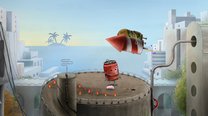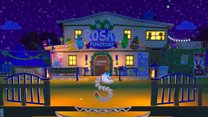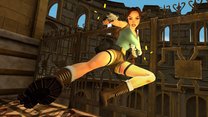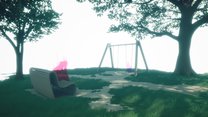Verne: The Shape of Fantasy review

- 0 Comments
Entertaining, shipshape side-scrolling adventure worthy of its namesake author
Nineteenth-century French author Jules Verne was a pioneer when it comes to science fiction stories. His fantastical adventure books have inspired many movies, TV shows and game adaptations over the decades, the latest being Verne: The Shape of Fantasy. Developer Gametopia is shooting for the moon with this steampunk-styled, side-scrolling adventure that sees players dive into an alternate world based on Verne’s stories in which the writer himself features as the main playable character. Aided by his fictional creation Captain Nemo, here he embarks on an interactive quest of literary proportions in search of the legendary lost power of Atlantis to defeat the tyrannous Nation, the world’s greatest warring superpower which is trying to take control of the entire planet. It won’t take eighty days to journey to the center of this mystery, especially because the puzzles are a bit on the light side, but you should enjoy almost every minute of it.
At the start of the game, you’re pulled down 20,000 leagues under the sea (literally), where Jules and Nemo salvage an ancient artifact called the “Compass of Destiny” from the ocean floor in a short cutscene. Immediately after, you’re thrown into the action yourself when the Nautilus comes under attack by The Nation’s biggest warship, captained by a man called the Bloody Raven, Nemo’s greatest enemy. You will have to find your way through the submarine’s many detailed corridors and rooms, climbing ladders, fixing electrical circuits, opening doors and clearing pathways of rubble to prevent the enemy from killing Nemo, taking over the Nautilus, and using the Compass to find the power of Atlantis for themselves.
Along the way you can scout for collectibles that provide background information about this world’s history and the real-life Jules Verne and his works, as well as random documents like letters and diary entries written by off-screen characters. (The latter can also activate side missions to find other items of the same type). While it may seem a bit counterintuitive to leisurely explore for such things when a self-destruct sequence has been activated and the vessel will implode in five minutes, I was quite interested in reading these little tidbits. (You could save them to read later by accessing them through the game’s menu.) Either way, it’s a shame the time spent reading isn’t accompanied by background music; scrolling through the text takes time and this particular section is so silent without it, in stark contrast to the great audio filling the rest of the game. Of course, you don’t have to read any of them if you don’t want to, since they serve only to provide flavor rather than clues to tackling the many obstacles you’ll encounter.

By this point you might be wondering how the entire situation came to pass. How did Jules and Nemo meet to begin with? Who is this Raven, some kind of steampunk version of Kylo Ren from the last Star Wars trilogy? And how can he and his forces be stopped? Well, you’ll get answers to these questions and more eventually, but not in a straightforward way because the seven – rather short, I must add; the game can be finished in six hours – chapters of Verne are told out of chronological order, and some story pieces are added through flashbacks, a technique often used in literature itself.
You guide Jules through his pixel art adventure by keyboard or controller; the mouse is only supported within the menu screens. The game world resembles more of a 2D side-scrolling platformer than a typical point-and-click adventure game world. You’ll spend most of your time moving from left to right and back again – you can either walk or run – and climbing up or down in search of puzzles, clues, and other characters to give you guidance. When you come near an interactive element, its hotspot pops up with a small icon indicating what you can do with it.
After leaving the Nautilus, you’ll travel through many different settings, from sandy beaches and rocky cliffs to dark and mysterious caverns. When exploring these locales, sometimes you find an examine-type hotspot that allows the camera to zoom out, showing off the immensity of the landscape you’re traversing with impressive vistas. The characters actually have recognizable faces, which isn’t always the case in modern pixel art games, and the scenery is beautiful, with small ambient flourishes like pulsating beams of light, moving machine parts, fish swimming past the windows of the Nautilus and lots more.
Verne features some original music but also borrows from classic composers like Bach, Wagner, and Debussy. When there’s no actual music, in its place are prolonged, spooky sound effects that accentuate the mood, especially the inner workings of the Nautilus: engine noises, hydraulic pumps, and electric sparks all sound impressive. The voice cast is top-notch and perfectly articulate, and I can very well imagine these actors performing on stage.

The Nautilus has many crew members, but not all of them will engage you in conversation. There’s Captain Nemo, of course, with whom you’ll interact the most. The doctor, Cedric, will help you uncover a lost memory, and there’s Nadine (who actually steers the submarine) and Edrielle, Nemo’s right hand, who both give you pointers along the way. And of course there’s the bad guy in this story, Raven, who tries to seduce you to betray Nemo and join him in conquering the world. The most important character is Jules himself, naturally, and he’s easy to identify with: a man constantly being torn between enthusiasm for the discoveries he makes and a fear of the unknown, of doing the wrong thing because of self-doubt.
During conversations with NPCs, you have limited time to choose a dialogue option, if a dialogue tree indeed appears at all (most conversations are more of a cutscene). A time bar slowly diminishes and if you haven’t picked a topic, once the timer runs out the conversation will automatically continue based on the highlighted option at that moment. You can’t exhaust all dialogue options; no matter what you choose it seems there will always be one topic left when the game automatically ends the discussion, but you won’t miss anything really important to fulfilling your quest, only more optional background information.
Main goals – like “make a keycard to open Nemo’s office” or “find shelter on the island” – are displayed in small title cards, both when they are assigned and completed. You can also check in the menu what your current goal is, along with a list of completed ones as well as unfinished tasks for side missions, like finding all the diary entries of an island castaway, or all inscriptions in the walls of a cave system.
To help himself along, Jules can utilize a mysterious artifact called the IMAG. When you encounter an obstacle, you can whip out this device to scan for “cracks in reality.” Finding one means you can actually create an alternate history for the obstacle in question. For example, at one point Jules needs to get to a lower level on the Nautilus, but the hatch is locked. A crew member lies dead beside it. At the press of a button Jules holds out the IMAG, activates it after you choose what needs to be changed from the cryptic possibilities displayed and says, “After climbing out the hatch, the crew member leaves it open before dying.” Then reality changes, and the hatch pops open, like some kind of time rewind. You have actively rewritten history!

Sometimes it’s easy and there’s only one choice to make with the IMAG, but other times you’ll have to deduce what actually created the obstacle and pick from several options. Choosing the wrong one will not have the desired result and you’ll have to try again after a few seconds while it reloads. It’s a clever mechanic but this device is heavily underused, in my opinion, as it could have spawned lots more ingenious puzzles.
Verne does have some other cool puzzles nicely integrated into this fictional science fantasy world, though all of them are fairly easy and won’t take experienced gamers long to solve. I prefer nothing too time-consuming myself, but seasoned adventurers might be put off by their simplicity. Your basic mechanical puzzles like sliders, dials, etc. are thrown in with a few inventory puzzles as you spend most of your time trying to get from point A to point B platform-style. Even when you don’t immediately see the logic behind them, a little bit of trial and error will get you to the solution.
The only exception is the game’s final puzzle of concentric circles in which rotating one also moves back another. There’s obviously some logic behind it too, but this particular puzzle is timed and will reset arbitrarily after 30 seconds, forcing you to start over again. You get unlimited tries, but there’s absolutely no reason why this particular puzzle should have a time limit, and to me there’s too big a contrast between its level of difficulty and those of the other puzzles throughout the game. I actually had to copy the circles on a piece of paper to figure out in which order and direction I would have to turn them in order to get the necessary pattern solution.
Indispensable in any good adventure story, unforeseen events in Verne often make your heart race. This effect is elevated by a sudden shaking camera and controller vibrations (if applicable), but you can turn these off if you prefer. Another way to add some tension is the occasional Quick Time Event. When backed into a corner, Jules needs to give the IMAG a huge blast, which demands a bigger charge. For this, you must quickly hit the directional buttons in a sequence shown on-screen. They’re not that hard, but don’t despair if you do make a mistake, as you get unlimited tries and you only have to do it a couple of times, usually when some kind of plot twist occurs at the end of a chapter. There are also some stealth sequences too, such as staying out of sight of an enemy’s searchlights, running from one hiding spot to the next without getting caught. Yes, you can die in Verne, but the game reloads automatically right before you failed, giving you another chance.
I do have a couple of pet peeves, and one of them is the distractingly exaggerated breathing animation developers often give pixel sprites, making them look as if they’re constantly trying to fly off into space. Another is that while you can fast-forward the dialogue during conversations, and usually when Jules is making comments on his own, you can’t always. It’s as if the skip function randomly goes missing at times. There are also some discrepancies between the voiced words and written subtitles, and even the occasional typo. And Verne only has a checkpoint function; there is a flashing icon to indicate when your progress is being saved, but it’s subtle, easy to miss and has no discernible pattern, so you may exit the game at your own risk. I noticed the game saving mid-chapter when I was simply moving through one of the many corridors aboard the Nautilus, so I’d say they come pretty regularly, and the one time I had to exit the game prematurely I had about five minutes to repeat.
Final Verdict
Despite a few minor nitpicks, Verne: The Shape of Fantasy is an exciting adventure that might very well seduce readers of fiction – especially the books of Jules Verne himself – to try out the interactive side of storytelling, and its relative ease makes it a good choice for newcomers. The world is very detailed and filled with lots of thrills, not to mention many different puzzles. Verne is dripping with love for the real author’s stories, and I applaud the developers for seamlessly interweaving fact and fiction and turning it into a fun if fairly short and easy game. I was left wanting more, in a good way, and if the teaser at the end is any indication, a sequel to this game is planned that I truly hope to see fulfilled. (Definitely stick around for a bit when the credits start rolling.) In the meantime, it may just inspire players to seek out the very novels that inspired it. That’s certainly true for me, as this enjoyable interactive adventure has motivated me to hitch a ride on the original Nautilus in book form next.
Hot take
The steampunk-styled world of Verne: The Shape of Fantasy provides a fun way to ease lovers of written fiction into interactive storytelling. It could have been written by Jules Verne himself, and although never very challenging, it is intriguing enough to keep more experienced gamers glued to the screen as well.
Pros
- Great variety in gameplay elements keeps things fresh
- An original story full of surprises, perfectly mixing facts with fiction
- Stageworthy voice cast and fitting classical music soundtrack
- Some clever and surprising plot developments
Cons
- Text could have used a bit more editing
- No manual save system
- Puzzles might be too easy for seasoned adventurers, except for the overly hard final one
Johnny played Verne: The Shape of Fantasy on PC using a review code provided by the game’s publisher.










0 Comments
Want to join the discussion? Leave a comment as guest, sign in or register.
Leave a comment